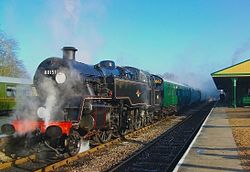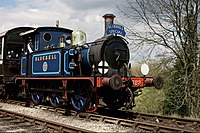Bluebell Railway
| Bluebell Railway | |
|
Sussex | |
|---|---|
 Horsted Keynes on the Bluebell Line | |
| Gauge: | Standard gauge |
| Location: | 51°1’58"N, 0°2’48"W |
| No. of stations: | 4 |
| Track: | 11 miles |
| Headquarters: | Sheffield Park station |
| Information | |
| Owned by: | Bluebell Railway Preservation Society |
The Bluebell Railway is an eleven-mile heritage railway line in Sussex. It is managed by the Bluebell Railway Preservation Society.
The railway uses steam trains which operate between Sheffield Park and East Grinstead, with intermediate stations at Horsted Keynes and Kingscote.
The Bluebell Railway is the first preserved standard gauge steam-operated passenger railway in the world to operate a public service. The society ran its first train on 7 August 1960, less than three years after the line from East Grinstead to Lewes had been closed by British Railways.[1]
On 23 March 2013, the Bluebell Railway started to run through to its new East Grinstead terminus station.[2] At East Grinstead there is a connection to the national rail network, the first connection of the Bluebell Railway to the national network in 50 years, since the Horsted Keynes – Haywards Heath line closed in 1963.
Today the railway is managed and run largely by volunteers. Having preserved a number of steam locomotives even before steam stopped running on British mainline railways in 1968, today it has over 30 steam locomotives, the 2nd largest collection in Britain after the National Railway Museum.[1] The Bluebell also has almost 150 carriages and wagons, most of them pre-1939.[1]
Contents
History
In 1877 an Act of Parliament authorised construction of the Lewes and East Grinstead Railway:[3] the line was sponsored by local landowners, including the Earl of Sheffield. A year later another act enabled the London, Brighton and South Coast Railway Company to acquire and operate the line.[3][4]
The line had six stations, but only Barcombe was within walking distance of a village. Chailey parish had two stations, one at Sheffield Park and the other at Newick and Chailey. It was customary for a rural line supported by a company or individuals to have stations close to the residences of its sponsors.[4] Thus Sheffield Park station was built for the Earl of Sheffield, and Newick and Chailey for Newick Park and Reedens, the homes of two other sponsors.[4] The other stations were at Kingscote, West Hoathly and Horsted Keynes. A branch ran from a junction at Horsted Keynes to Ardingly and Haywards Heath on the London, Brighton and South Coast main line.[4]
The line was built to take double track. However, only the section between East Grinstead and Horsted Keynes (and thence to Haywards Heath via Ardingly) was laid as such; south of the junction at Horsted Keynes the line was single track with passing loops at stations. The line was opened in 1882.[4]
Goods traffic on the line consisted of local produce; milk: farm products and coal, and timber to and from Albert Turner & Son, a sawmill. The only time Sheffield Park received a substantial number of passengers was when Lord Sheffield entertained the Australian cricket team, with a match between them and Lord Sheffield's own team.
In 1954, long before the Beeching Axe, the branch line committee of British Railways proposed closing the line from East Grinstead to Culver Junction near Lewes.[5] This was challenged by local residents, but closure was agreed in February 1955 for 15 June 1955, although the line closed on 29 May due to a rail strike.[3] An acrimonious battle between British Railways and the users of the Bluebell Line then ensued, and lasted three years.[5]
Shortly after closure, Margery Bessemer of Chailey discovered in the 1877 and 1878 Acts of Parliament the clause relating to the "Statutory Line", and demanded British Railways reinstate services, so on 7 August 1956 British Railways reopened the line,[5] with trains stopping at stations mentioned in the acts. British Railways took the case to the House of Commons in 1957 and later the Transport Commission persuaded Parliament to repeal the special section of the Act. The line was finally closed on 17 March 1958.[3][5]
Preservation
On 15 March 1959 a group that included the future president of the society, Bernard Holden, met in Ardingly and formed the Lewes and East Grinstead Railway Preservation Society. The society elected John Leroy as the first chairman, and £940 was raised in donations to start the society. On a vote at the meeting, the society changed its name to the Bluebell Railway Preservation Society.[1]
The society's initial aim was to reopen the whole line from East Grinstead to Culver Junction as a commercial service, using a two-car diesel multiple units.[1] The plans came to nothing: the society failed to buy the whole line, and most local residents were not interested.[1] The committee then recommended that the stretch of track between Sheffield Park and Horsted Keynes could be run as a tourist attraction, with vintage locomotives and stock operated by unpaid volunteer staff.[1]
Sheffield Park to Horsted Keynes
As BR still ran an electrified line from Horsted Keynes to Ardingly,[5] the society leased a stretch of track from BR just south of this.[5] In 1960 the interim line was opened, running from Sheffield Park to Bluebell Halt, 100.0 yards (91.4 m) south of Horsted Keynes. In 1962 the society extended services to Horsted Keynes. Also in 1962 a halt was opened at Holywell (Waterworks). However, this was closed the following year. BR withdrew passenger services from Horsted Keynes to Haywards Heath in 1963; and with complete closure of the line north of Horsted Keynes, the Bluebell Line was severed from the BR system.
Horsted Keynes to Kingscote
In 1974 the society purchased the freehold of the demolished West Hoathly station, allowing the first steps to be taken towards an extension northwards towards East Grinstead station. It then purchased the freehold of the site of Kingscote station in January 1985.[6] A Light Railway Order was obtained for an extension to East Grinstead in 1985.[6]
The Bluebell Railway Preservation Society completed the extension from Horsted Keynes to Kingscote in April 1994,[6] re-laying track through Sharpthorne Tunnel, which at 731 yards is the longest on a British heritage railway. At the north end of Sharpthorne Tunnel, the line passes through the site of the former West Hoathly railway station. It was demolished in 1967, but remains of the platforms and goods dock are still visible.
Kingscote to East Grinstead via Imberhorne
From its inception, the society had always planned to work northwards towards East Grinstead, where the line would connect with the national network. BR donated Imberhorne Viaduct to the railway in 1992, but it took until 2003 to purchase the trackbed.[1]
A major problem was the landfill site filling a railway cutting 30 feet deep just south of Imberhorne Viaduct, filled with domestic waste by East Grinstead Town Council in the 1960s and 1970s. Clearance of the clay cap, foliage and suurounds belayed the actual clearance of rubbish until November 2008.[7]
In Autumn 2008 work started on site clearance at East Grinstead for construction of the new station about 100 yards south of the national rail station.[1]
On 7 March 2013, the last section of track was formally joined using a white fishplate, with the honour of tightening the four bolts being given to Barbara Watkins, a long-standing Bluebell Railway volunteer.[8] The extension to East Grinstead was officially opened on Saturday 23 March, with a two-week opening festival starting that day.
Stations
The various stations have been restored to show different periods of the railway's life:
- Sheffield Park has been restored to a Victorian ambience, as it would have appeared during the time of the London, Brighton and South Coast Railway (up to 1922)
- Horsted Keynes emulates the Southern Railway from 1923 to 1947
- West Hoathly (if built) will emulate the British Railways of the late 1940s
- Kingscote echoes the British Railways of the 1950s
- East Grinstead is an amalgam of British Railways of the 1950s and 1960s
Rolling stock
The Bluebell Railway preserved a number of steam locomotives before the cessation of steam service on British mainline railways in 1968. Today it has the largest collection - over 30 - of steam locomotives in the United Kingdom after the National Railway Museum. The society also has a collection of almost 150 carriages and wagons, most of them pre-war. A project is under way to recreate a long-lost type of locomotive (LB&SCR H2 class Atlantic) from a few surviving parts.
Outside links
| ("Wikimedia Commons" has material about Bluebell Railway) |
- The Buebell Railway]
- Bluebell Railway Preservation Society
- "Miss Bessemer Saves The Train" (Radio 4 drama)
References
- ↑ 1.0 1.1 1.2 1.3 1.4 1.5 1.6 1.7 1.8 Michael Welch (31 May 2010). The Bluebell Railway: Five Decades of Achievement. Capital Transport Publishing. ISBN 978-1854143365.
- ↑ "Sussex sees first steam train on extended Bluebell Railway". BBC News. 23 March 2013. https://www.bbc.co.uk/news/uk-england-sussex-21853230.
- ↑ 3.0 3.1 3.2 3.3 Awdry, Christopher: Encyclopaedia of British Railway Companies (1990, Patrick Stephens Ltd) ISBN 1-8526-0049-7}}, pp 189-190.
- ↑ 4.0 4.1 4.2 4.3 4.4 Turner, John Howard (1979). The London Brighton and South Coast Railway 3 Completion and Maturity. Batsford. ISBN 0713413891.
- ↑ 5.0 5.1 5.2 5.3 5.4 5.5 Julian Holland (22 Feb 2013). Dr Beeching's Axe 50 Years On: Memories of Britain's Lost Railways. David & Charles. ISBN 978-1446302675.
- ↑ 6.0 6.1 6.2 "Bluebell Railway Extension". Bluebell-Railway.co.uk. http://www.bluebell-railway.co.uk/bluebell/extend.html.
- ↑ "Rubbish cleared for steam trains". BBC News. 25 November 2008. http://news.bbc.co.uk/1/hi/england/sussex/7747542.stm.
- ↑ "15 March 2013: The Line Is Joined!". Bluebell Railway. http://www.bluebell-railway.co.uk/bluebell/ext/extprog.html#15mar13.





